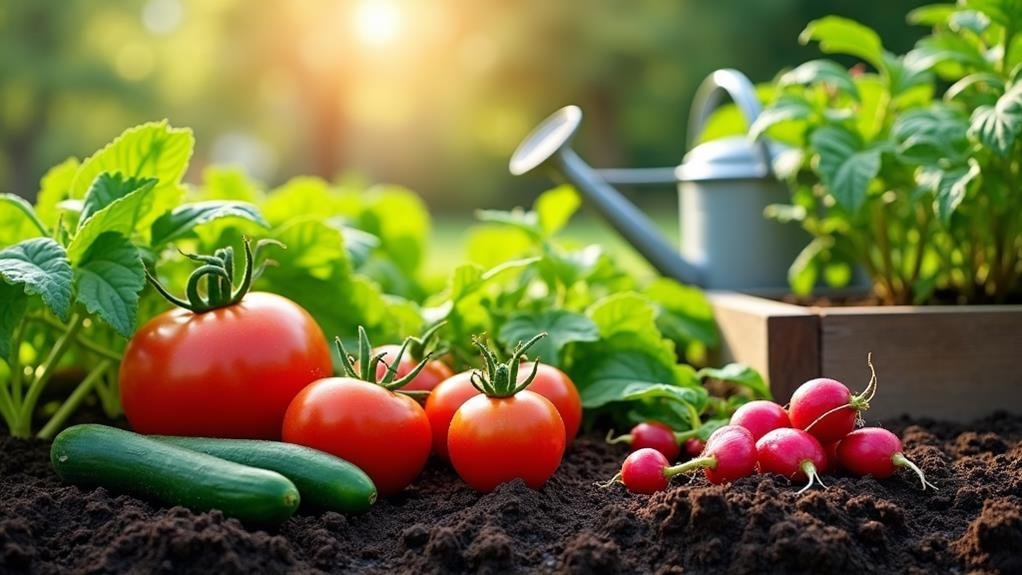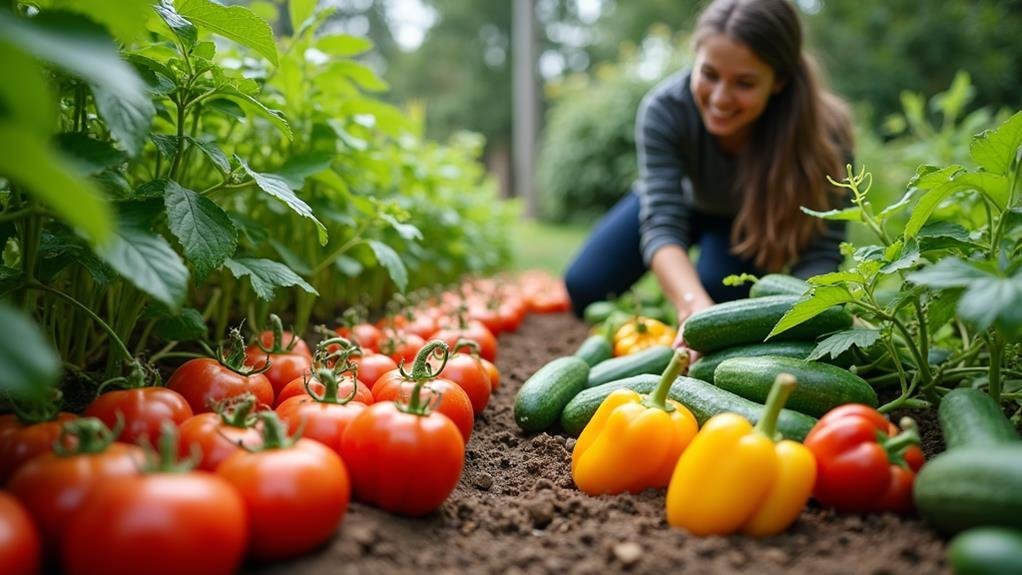When you're new to gardening, starting with easy vegetables can set the stage for success. These beginner-friendly crops, like radishes and zucchini, not only require less maintenance but also offer quick rewards that build your confidence. You'll find that their resilience against pests and diseases makes the experience less stressful, allowing you to focus on the joy of growing. But what specific vegetables should you consider, and how can you guarantee they thrive in your garden? Let's investigate the best options and tips to get you started.
Benefits of Easy Vegetables

In the area of gardening, many beginners find that choosing easy vegetables can make all the difference. Starting your gardening journey with simple crops not only boosts your confidence but also helps you develop essential skills.
These vegetables typically require less maintenance and are more forgiving of mistakes, allowing you to learn as you grow. You'll notice that easy vegetables often have quicker harvest times, which means you can enjoy the fruits of your labor sooner.
This immediate gratification can be incredibly motivating, encouraging you to keep going with your gardening efforts. Plus, they tend to be more resilient against pests and diseases, reducing the stress that comes with managing your garden.
Another benefit is that easy vegetables are usually versatile in the kitchen. Whether you're roasting, steaming, or tossing them in salads, you'll find they fit seamlessly into your meals.
As you become more comfortable with gardening, you might even want to experiment with more challenging plants, but starting with easy vegetables lays a solid foundation. So, jump in, enjoy the process, and watch your gardening skills flourish as you cultivate your patch of greenery!
Top Beginner-Friendly Vegetables
Choosing the right vegetables can set you up for success as you start your gardening journey. Some beginner-friendly options will make your experience enjoyable and rewarding.
First, consider growing radishes. They're quick to sprout and can be harvested within weeks, giving you an instant sense of accomplishment.
Next, lettuce is an excellent choice. It grows rapidly, and you can enjoy fresh salads right from your garden. You'll love how easy it's to pick a few leaves whenever you need them.
Another great option is zucchini. It's prolific, meaning a few plants can yield a bounty of squash throughout the summer. Plus, it's versatile in the kitchen!
Don't forget about green beans. They're hardy and can climb trellises, saving space while providing a delicious crop.
Growing Conditions to Consider

Understanding the growing conditions for your chosen vegetables is vital for a successful garden. First, consider the sunlight requirements. Most vegetables thrive in full sun, meaning they need at least six to eight hours of direct sunlight daily. If your garden area is shady, you might want to choose shade-tolerant varieties.
Next, think about soil quality. Vegetables prefer well-draining soil rich in organic matter. Conduct a soil test to check pH levels and nutrient content, and amend the soil as needed. This can make a significant difference in your plants' growth and yield.
Watering is another key factor. Different vegetables have varying water needs, so make certain you understand how much water your chosen plants require. Overwatering can lead to root rot, while under-watering can stunt growth.
Lastly, pay attention to temperature. Most vegetables prefer warm weather, so plant them after the last frost date in your area.
Simple Care Tips for Success
Once you've established the right growing conditions, maintaining your garden becomes the next priority. Start by watering your plants consistently, aiming for about an inch of water per week. Early morning is the best time to water, as it allows the plants to absorb moisture before the heat of the day.
Next, keep an eye out for weeds. These pesky intruders compete for nutrients and water, so remove them regularly to give your veggies the best chance to thrive. Hand-pulling works well, or you can use mulch to suppress their growth.
Fertilizing is also vital. A balanced, slow-release fertilizer can provide the necessary nutrients. Just be sure to follow the package instructions, as too much can harm your plants.
Pest control is another important aspect. Check your plants frequently for any signs of pests or disease. If you spot any issues, address them quickly, either by using organic solutions or by attracting beneficial insects that can help keep pests at bay.
Harvesting and Enjoying Your Vegetables

Harvest time is one of the most rewarding moments in gardening, as you finally get to enjoy the fruits of your labor. When your vegetables reach their peak size and color, it's time to gather them. Pay attention to each type; some vegetables, like cucumbers and zucchini, should be picked while they're still small for the best flavor. Others, like tomatoes, should be fully ripe before harvesting.
Use clean, sharp tools to avoid damaging the plants. Gently twist or cut the vegetables from their stems, ensuring you leave some of the plant intact to continue growing.
You'll want to pick your veggies in the morning when temperatures are cooler, ensuring they retain their moisture and crispness.
Once you've harvested, rinse your vegetables thoroughly to remove any dirt. Then, enjoy them fresh in salads, stir-fries, or roasted dishes. You can also share your bounty with friends and family, spreading the joy of your gardening efforts.
Don't forget to savor the taste of your hard work. There's nothing quite like the satisfaction of enjoying a meal made with your own homegrown vegetables!
Happy harvesting!
Common Mistakes to Avoid
Many new gardeners make common mistakes that can hinder their success. One of the biggest errors is overwatering. You might think more water means healthier plants, but too much can drown roots and lead to rot.
Instead, focus on the soil's moisture level—water only when it's dry a couple of inches down.
Another frequent pitfall is planting too closely. It's tempting to pack in as many veggies as possible, but overcrowding can stunt growth and increase disease risk.
Make sure to follow spacing guidelines for each type of vegetable.
Don't forget about sunlight! Many new gardeners underestimate how much sun their plants need.
Most vegetables thrive with at least six hours of direct sunlight daily, so choose your planting spot wisely.
Lastly, avoid skipping soil preparation. Healthy plants start with rich, well-draining soil.
Take the time to amend your soil with compost or nutrients before planting.
Conclusion
Starting your gardening journey with easy vegetables can be incredibly rewarding. By choosing beginner-friendly options like radishes and zucchini, you'll quickly build confidence and enjoy the fruits of your labor. Remember to pay attention to growing conditions and care tips to guarantee success. Avoid common mistakes, and soon you'll be harvesting and savoring your homegrown produce. Welcome the experience, and you might just find gardening is one of your new favorite hobbies!




